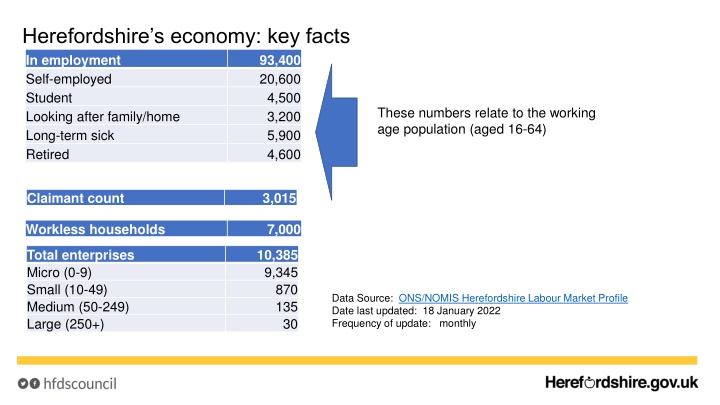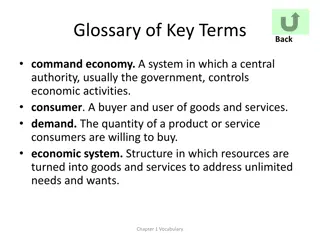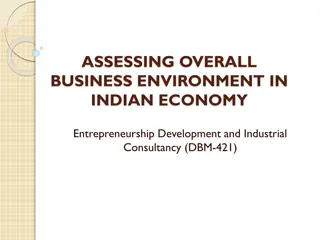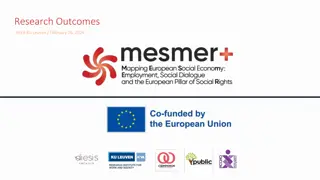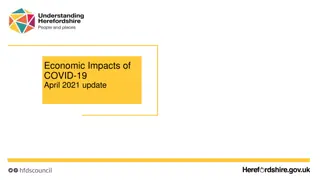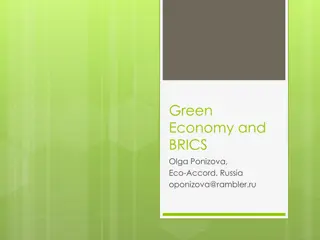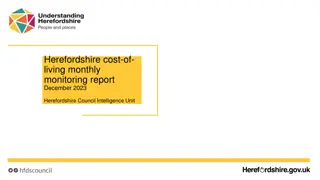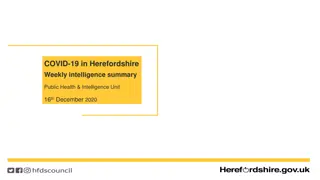Herefordshire's Economy Overview: Key Facts & Insights
Herefordshire's economy snapshot includes employment statistics, earnings data, and gender pay gap insights. Discover key facts about industries, workforce distribution, and earnings trends in the region.
Download Presentation

Please find below an Image/Link to download the presentation.
The content on the website is provided AS IS for your information and personal use only. It may not be sold, licensed, or shared on other websites without obtaining consent from the author.If you encounter any issues during the download, it is possible that the publisher has removed the file from their server.
You are allowed to download the files provided on this website for personal or commercial use, subject to the condition that they are used lawfully. All files are the property of their respective owners.
The content on the website is provided AS IS for your information and personal use only. It may not be sold, licensed, or shared on other websites without obtaining consent from the author.
E N D
Presentation Transcript
Herefordshires economy: key facts In employment Self-employed Student Looking after family/home Long-term sick Retired 93,400 20,600 4,500 3,200 5,900 4,600 These numbers relate to the working age population (aged 16-64) Claimant count 3,015 Workless households 7,000 Total enterprises Micro (0-9) Small (10-49) Medium (50-249) Large (250+) 10,385 9,345 870 135 Data Source: ONS/NOMIS Herefordshire Labour Market Profile Date last updated: 18 January 2022 Frequency of update: monthly 30
Herefordshires most and least competitive industries (2020-2021) Source: Emsi- economicmodelling.co. uk Date last updated: 11 January 2022 Frequency of update: annual HC data lead: Intelligence Unit Need to know: Competitive effect explains how much of the change in a given industry is due to some unique competitive advantage that the region possesses. This effect is calculated by taking the total regional growth and subtracting the national growth for the same industry. The regional growth that remains cannot be explained by national trends in that industry or the economy as a whole.
Earnings The latest Annual Survey of Hours and Earnings (ASHE) reveals that the workplace-based median weekly earnings for people who work in Herefordshire is now 536.60 ( 42.07). Herefordshire s weekly earnings are significantly lower than that in England 613.30 ( 2.40). Herefordshire s weekly earnings are not recorded as significantly different to the West Midland region s in 2021, although the amount is lower 585.0 ( 11.47). The county has the lowest median earnings of all 14 West Midlands authorities, also, consistently ranked as amongst the lowest in England and Wales (14th out of 111 top-tier authorities in 2021 provisional figures). Annualised earnings are 27,980 ( 2,194), also significantly lower England 30,979 ( 125) but similar to the West Midlands region, 30,504 ( 598). If we look at residents based weekly earnings as opposed to work place based weekly earnings, these are 535.50 ( 67.17) and although lower compared to England and the West Midlands region although the differences are not significant. Source: Annual Survey of Hours and Earnings (ASHE) available from NOMIS Frequency: annual Last updated: November 2021. Need to know: workplace-based earnings includes all people who work in Herefordshire regardless of which county they live in. Residents-based weekly earnings includes all people who live in Herefordshire i.e. includes those who work outside the county
Gender pay gap The gender pay gap (GPG ) is the difference between average hourly earnings (excluding overtime) of men and women as a proportion of average hourly earnings (excluding overtime) of men. In 2021, women s earnings in Herefordshire are 4% lower than men s; a smaller gap compared the West Midlands region (10%) and England (9%). Although the gap is now 25% lower than it was a quarter of a century ago, it is still around 13 percentage points and in 2019 the average working-age woman in the UK earned 40% less than her male counterpart. Recent research by the IFS as part of the Deaton Review found that the vast majority of the modest convergence in earnings of the past 25 years can be explained by the closing of the gender gap in education levels. The divergence occurs with parenthood, when the gendered roles that mothers and fathers take on appear to be largely unrelated to their relative earnings potential. Source: Annual Survey of Hours and Earnings (ASHE) available from NOMIS Frequency: annual Last updated: November 2021 The IFS found that persistent social norms around parenting are reinforced by a policy environment that sustains and incentivises a traditionally gendered division of labour, even when policies are ostensibly gender-neutral.
2020 Labour Force Breakdown Source: Emsi-economicmodelling.co.uk Frequency: annual Last updated: December 2021
Herefordshires largest industries (by jobs) Source: Emsi- economicmodelling.co.uk Date last updated: 16 December 2021 Frequency of update: daily HC data lead: Intelligence Unit
Herefordshires largest occupations Source: Emsi- economicmodelling.co.uk Date last updated: 16 December 2021 Frequency of update: daily HC data lead: Intelligence Unit
Job postings in Herefordshire According to EMSI, in Herefordshire there were a total of 10,375 unique job postings in November 2021. This compares to 9,176 in the previous month. Locally, job postings are now significantly higher than in the same period a year ago. This, in combination with the claimant count data appears to suggest that Herefordshire s economy was pre-Omicron recovering well from the economic turbulence of the past twelve months. As at 15 December 2021 there were 6,693 unique job postings; 54.9% higher than on the same day last year. Top posted occupations in November 2021 were nurses, care workers and home carers, book-keepers, payroll managers and wages clerks, van drivers, sales and retail assistants, and sales accounts and business development managers. Source: Emsi- economicmodelling.co.uk Date last updated: 16 December 2021 Frequency of update: daily HC data lead: Intelligence Unit Need to know: A unique job posting is one that has been de-duplicated as postings can appear on multiple websites, multiple times. Data include voluntary, internships, side jobs and freelance.
Top 10 in-demand skills in Herefordshire In 2021 as a whole the top ten in-demand skills in Herefordshire (with number of citations) were: Nursing 1,109 Auditing 1,103 Finance 958 Personal Care 902 Mental Health 869 Warehousing 846 Accounting 769 Key Performance Indicators (KPIs) 656 Learning disabilities 644 Machinery 553 Need to know: Hard skills are abilities that have been taught to or learnt by a person. Source: Emsi- economicmodelling.co.uk Date last updated: 16 December 2021 Frequency of update: monthly HC data lead: Intelligence Unit
Hot and cold hard skills in Herefordshire Hot and cold hard skills compared to 1 month ago (October 2021) Hot and cold hard skills compared to 1 year ago (November 2020) Need to know: Hard skills are abilities that have been taught to or learnt by a person. Source: Emsi- economicmodelling.co.uk Date last updated: 16 December 2021 Frequency of update: monthly HC data lead: Intelligence Unit
Hard-to-fill vacancies There is no standard definition of a hard-to-fill vacancy but the chart shows occupations where there have been 10 or more unique Herefordshire job postings in October/November 2021 by median posting duration and job posting intensity. This is the most timely proxy for hard-to-fill vacancies and although there are some issues associated with this methodology has been shown to be a robust approximation. Those roles that appear highest on the chart for both measures can be regarded as most hard-to-fill . Nationally, ONS reports that the number of job vacancies in October to December 2021 rose to a new record of 1,247,000, an increase of 462,000 from its pre-coronavirus January to March 2020 level, with most industries displaying record numbers of vacancies. However, the rate of growth in vacancies continued to slow down. The ratio of vacancies to every 100 employee jobs reached a record high 4.1 in October to December 2021. Need to know: Posting Intensity is a ratio of total job postings to unique, or de-duplicated, job postings. A higher than average posting intensity can mean that employers are putting more effort than normal into hiring that position. Posting intensity is available by occupation, by job title, by company, and by region. The median posting duration (how long a posting was live before it was taken down) can be compared to the regional average for all postings in the region, giving an indication of whether these positions are harder or easier to fill than the typical job posting. Source: Emsi- economicmodelling.co.uk Date last updated: 16 December 2021 Frequency of update: quarterly HC data lead: Intelligence Unit
Workforce educational attainment Source: Emsi- economicmodelling.co.uk Frequency: Annual Last updated: December 2021
